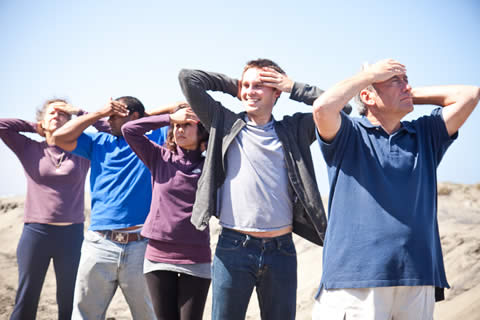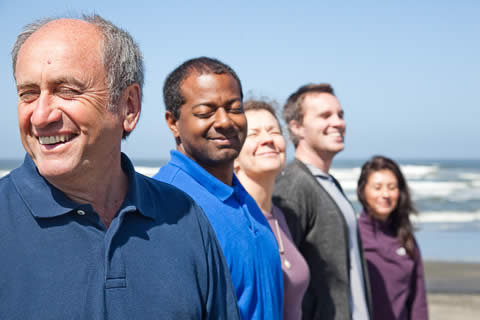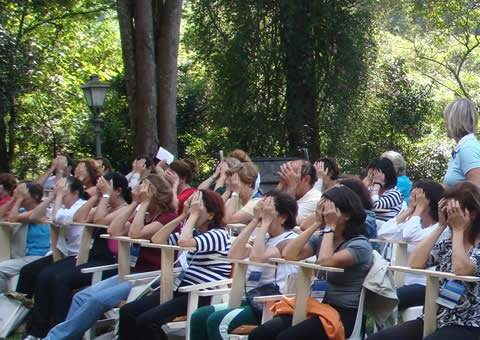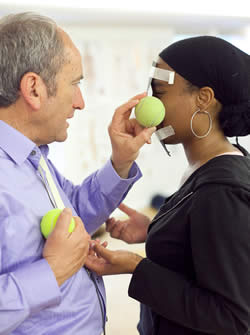Positive Health Online
Your Country

Natural Vision Improvement for Children and Adults
by Meir Schneider and Melissa Moody(more info)
listed in vision and eye sight, originally published in issue 175 - October 2010
It is said that the eyes are the windows to the soul. But, they can also be mirrors that reflect your overall health, as well. What then do we make of the 66% increase in cases of myopia (nearsightedness) that afflict the "internet generation today?"[1] Thankfully, natural vision improvement is possible.
How you see is part of your body's dynamic posture. The entire body participates in seeing poorly, and a lot of strain and muscle tension goes into inappropriate use of the eyes. Thus, the pain in your eyes, scalp, neck, shoulders and upper back as you work on a stressful task at your desk are part of the same problem. Therefore, it is important to attend to the needs of your eyes.

Beginning with my journey out of blindness and experience from thousands of other cases, I have found that we can improve our eyesight, reduce muscle stiffness and pain, and improve the health of the whole body, through a program of eye exercises, movement, and massage/self-massage. Applying the holistic Method of Self-Healing, we create a more relaxed, balanced use of the body - and the eyes - which can bring dramatic improvement for people of all ages. This can literally be the difference between darkness, and the light of day.
I was born blind from congenital cataracts, nystagmus, glaucoma and small corneas. Unsuccessful surgeries left my ocular lenses shattered and full of scarred tissues. The medical diagnoses of permanent blindness set a cloud of doubt upon the situation, so I learned to read Braille until I was seventeen. However, this changed when I discovered the Bates Method of eye exercises. I devoted myself to a practice of vision improvement that was first developed by Ophthalmologist William H Bates.[2] Adding my own intuitive exercises of massage and movement therapy, I was able to self-heal myself, and subsequently, put together an integral Self-Healing Method. I now have an unrestricted California driving license.
Parents should know that the plasticity and ability of the brain and body to heal is especially effective for children. I have seen kids accomplish vision improvements in 30 minutes when it takes adults 3 times as long. This is good news because the visual stress caused by computers, cell-phones, and even school sessions are linked to many refractive problems.[3] This is great news, considering that corrective care for refractive errors amounts to an estimated $3.8 billion to $7.2 billion annually.[4]
We can endure anything ourselves, but pain is magnified when it comes to our children. It was an incredibly tense moment when I learned that my son, Gull, was born with cataracts. I refused to have him raised visually impaired, as I had been. Luckily, surgeries are better today than they use to be. However, most people born with cataracts end up with 20/80 vision - vision that is half of normal. Working with my son, we were able to restore his vision to 20/40, and 20/15 with glasses.
Unlike adults, children often are not motivated to work on their vision. However, one can implement fun activities that naturally strengthen vision. Swinging, for example, is a great activity because constant distance changes between objects strengthen the ability of eyes to focus. If you are facing the child who is swinging, you can call for their attention by constantly being playful (making faces, stealing their hat, catching their feet). Playing catch, jumping on trampolines, and juggling have also been effective at helping kids and adults improve their visual functioning.
One thing I try to emphasize with parents is the important role they have in promoting visual activities that maintain their children's optimal health. One fun and helpful technique I used with my son was working with his innate creative interests and having him draw objects that he could see in the world around him.
Do you know that 'sparkle' that some people have in their eye? The sparkle is made up of tiny and quick movements associated with healthy eyes. In perfect vision, the eyes move effortlessly from one small detail to another, skimming the world like a butterfly. Dull and fixed stares that are not rich in detail create the perception of a world that is one big undifferentiated item. Shifting your vision from a smaller to larger text, from close objects to distant vistas, and conscientiously blinking your eyes will refresh your eyes and increase the vivid beauty of the world around you.
The increase of people using computers, playing video games, and working at cramped cubicles requires that we all become conscious of ways to protect ourselves and our loved ones from the physical and visual strains associated with the 21st century lifestyle. Children that do not get enough exercise and stay indoors will lack the eye movement and natural sunlight that is necessary for sustaining healthy eyes.
To eliminate and recover from eyestrain, it is critical to learn how to rest the eyes while using the computer, how to pay attention to peripheral vision and how to frequently, look briefly far into the distance. Without healthy eye habits, the cumulative effects of computer use can be devastating.
Those of us with bad eyesight are using our eyes anxiously - reaching with them, and craning the head forward, as if the eyes were trying to arrive a few seconds ahead from the rest of the body. It is important to see poor eyesight and its posture as part of a whole-body response to chronic stress. This stress is likely to involve a cognitive-emotional strain, or, as Dr William H Bates put it, "a strain of the mind," linked with prolonged work.[5]

They help the eye shape to the admittance of light
The visual stress from computer use tends to bring on nearsightedness or make it worse; it can also worsen farsightedness. Like carpal tunnel, Computer Vision Syndrome (CVS) is a repetitive strain syndrome in which the ciliary, a small muscle within the eye that changes the shape of the lens to determine the focus, is strained. The brain tells the ciliary to set up the focus for a given distance, 16 inches, for example. To figure out that the page you are reading is 16 inches away from your eyes, your brain analyzes the edges and spaces of the letters. Unfortunately, there is neither definite edge nor space on a computer screen. There are only pixels - tiny, fuzzy grey dots. Bereft of essential clues, the brain endlessly searches for a focal length that can never be found. This is as if you decided to exercise your biceps by quivering them through an inch or so of their range for hours on end, rather than doing biceps curls through the full range of movement for a few minutes.
I once worked with a 50 year-old computer programmer whose vision had degenerated to 20/140. Mitch found 'sunning' to be a stimulating eye exercise. It involves helping the eye adjust to varying intensities of light. This exercise reduces squinting, which profoundly strains the eyes and creates tension in the face muscles. After working with me for one year, Mitch was able to pass the DMV test (the cut-off is 20/50) and remove the restriction for glasses. He was also able to work more efficiently, as computer glare and fluorescent lighting no longer bothered him as much as it had before.

helping Meir get his driver license
Palming is another exercise that effectively restores good circulation to the neck, face, and eyes. It involves visualization of the colour black (deep purple or navy blue are acceptable substitutes). Start with some gentle upper-body stretches, or shake out tension by jumping on a mini-trampoline. Darken the room, play soft music if you like, and position yourself for maximal comfort, with your elbows well supported. Gently massage the back of your neck, your scalp, jaws, and forehead, and along the eyebrow ridge and cheekbones. Now warm your hands by rubbing them together and drop your shoulders. Close your eyes. Gently cover them, without pressure and with your cupped hands, resting the heels of your hands on your cheekbones. Breathe deeply. Now start to imagine ever-deepening blackness - a school of fish near the ocean floor, a black horse trotting along a starlit beach, or the world around you turning black, one object at a time. You may experience eyestrain that you have been shutting out; stay with it until it clears up. (It is important for glaucoma patients to limit this type of exercise to five minutes - but repeat often throughout the day!) With children, you can tell a story, or take turns making up a story; just include images of darkness, like chocolate soup or dark mud.
With both of my kids, I was told that they would always depend on glasses and external help, since their ocular lens was removed. However, a simple ball-rolling exercise proved to reduce and eliminate their dependence. We would construct an opening, a goalie, between two goals, while my daughter watched the ball roll, slowly, back in and out. This exercise was also crucial for improving coordination between the eyes and helped balance the eye-body dynamics associated with posture. You might try it out in a dark room with glow in the dark balls as well!
Yoginis, or practitioners of yoga, have been defined as "someone who knows that the entire cosmos is situated within his own body."[6] Now that people have begun to realize the power of the mind-body connection, it is time for us to realize that we can do "Yoga for our Eyes" as well.[7]

| Promoting Relaxation of the Visual System, Developing Healthy Ocular Habits, Natural Vision Improvement Exercises |
| Eye Exercises
|
Postural dynamics and shallow breathing are often connected to the vision problems people experience from computer use, as well as other sedentary habits. We sit in offices, living rooms and airplanes. We sit in front of TVs and computers. Cumulatively, the body becomes stiff, rigid and unfeeling. Little by little, joints and muscles degenerate and eyesight deteriorates. At the computer, we sit with hunched, rounded shoulders and a forward head and tend to ignore our periphery until it shrinks, and our central vision becomes strained. Many bifocal wearers tilt the head upward to aim the bifocal inserts at the screen. Worst of all, we, and our children, suppress the pain from the hours of eyestrain and bad posture.
Prevent degeneration by becoming more alive, and become conscious of your body and eyes. When you are tense, notice if you are fatigued or hunching your shoulders. Fatigue and tension constricts circulation. Working at the computer strains the face, the eyes and the body. Many people believe in ergonomics as a solution for computer-related problems. While sitting differently at your desk can be helpful, periodically standing and holding your foot and stretching your leg backward is even more effective. Breathing deeply from time to time is also helpful. Most people do not realize that when concentrating, whether in front of a computer or not, they have a tendency to breathe shallowly or hardly breathe at all.
Take a break and try to find a place with pleasing scenery. Wiggle your shoulders to loosen them, breathe deeply, and blink gently for three minutes, imagining that the tips of your eyelashes are leading the motion. Letting your eyes remain soft, look at small details in the distance. Isn't it easier to enjoy the beauty of the scene once the eyes are relaxed? The increased circulation and reduced strain of palming and blinking lend to a vibrancy that replaces the dullness of tired eyes.
Self-healing through natural exercises is an invaluable tool for all families and communities as it is documented to: provide rehabilitation of injuries, nurture health as a preventative measure against illness, as well as exist as a holistic health-care system that is crucial, especially considering the shortcomings of national (and international) health care availability.
When we understand the dynamics of the mind-body-visual system, we experience first-hand that seeing clearly is a good sign of our overall health and vitality.
References
1. Paul AS. National Institutes of Health. Healthy Vision Month. www.nei.nih.gov/news/pressreleases/043010.asp May 2010.2. Bates WH. The Cure for Imperfect Sight by Treatment Without Glasses. Central Fixation Publishing CO. New York City. 1920.
3. Press Release. Computer vision syndrome threatens returning students. American Optometric Association. www.aoa.org August 7, 2007.
4. Mavracanas TA, Mandalos A, Peios D, et al. Prevalence of myopia in a sample of Greek students. Acta Ophthalmol Scand 78 (6): 656-9. doi:10.1034/j.1600-0420.2000.078006656.x. PMID 11167226. December 2000.
5. Bates WH. IBID.
6. Feuerstein G. The Shambhala Encyclopedia of Yoga. Shambhala Publications. Boston. 1-2. p. 321, 350. 2000.
7. Schneider M. Yoga for Your Eyes. The School for Self-healing. www.self-healing.org/top-menu/services/workshops . 2010.
Further Information
In November 2010, Schneider will present at the British Natural Eyesight Conference in London, http://www.bnec.org.uk/ a conference for those interested in exploring the field of natural and alternative therapy for children's eyesight. Please visit www.self-healing.org
Comments:
-
No Article Comments available